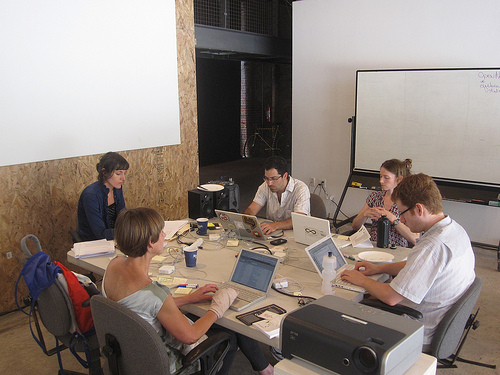Challenges that third parties face: The Tyranny of Structurelessness

Third parties are resurgent now. Voters are increasingly unhappy with the two major parties and are looking for alternatives. Maybe you're already in a third party, or are thinking of joining or maybe even starting one. Give some time to thinking about the structure of the party and how decisions are to be implemented, as this can be all-important in its effectiveness.
I was Co-coordinator of the Green Party of Los Angeles County Council from about 2001-2003 and got to see first-hand what happens when the structure is so loose that decision-making becomes paralyzed. This is not meant to bash the Green Party, but to be viewed as an instructive example of what to avoid and how decisions made with the best possible of intentions can have unfortunate consequences.
The Green Party of California operated then, and no doubt still does, with a consensus style of governing. Decisions are meant to be arrived at collegially with confrontations frowned upon. Thus, the threshold for passing a measure was sometimes quite high, with anywhere from 66% to 80% of the vote required for passage. Everyone was supposed to be on board when decisions were made. To avoid undue argument, a "vibes watcher" was appointed at the beginning of each meeting who would say "vibes, vibes" in an attempt to calm council members down if discussions got too heated. No, I am not making this up, and yes it seems comical to outsiders. But again, this was no doubt started for the best of reasons, so as to to have friendly disagreements, not knock-down drag-outs. (And - full disclosure here - I had "vibes" called on me more than once.)
This leads to my first point. The structure you have when your party is tiny and meeting in someone's living room will not be able to scale when you have hundreds and then thousands of members, especially after most no longer know each other personally. Keeping the disagreements friendly and low-key is doable when twelve committed core members meet in a living room. It is not possible when 750 members are coming to your convention. Rules and structures that worked in the early days may soon become counter-productive.
Second, and equally important, such overly loose structure can easily be gamed by a determined minority who essentially can take control and block change from happening. Jo Freeman talks about this in her now-classic The Tyranny of Structurelessness which she wrote in 1971 as the women's movement was moving from groups in living rooms to major political organizing.
Her major points are 1) In the absence of formal structure, informal friendship structures will take over and will be used by a few to grab power because there's nothing to stop them from doing so. 2) Unstructured groups aren't effective in getting things done. Someone needs to be in charge and give directions with an assumption the work will get done. Otherwise it's like herding cats. 3) What makes some small groups highly effective cannot be duplicated in larger groups. Again, the processes do not scale. New processes, structures, and approaches are needed. 4) "The only groups that can organize a national activity are nationally organized groups." Sounds obvious, doesn't it? But unstructured groups sometimes think they can have a national impact. Not so.
Her thoughts on how to effectively organize a democratically structured organization or party are 1) delegate authority specifically and democratically, 2) require authority to be responsible to those who choose them (that's "require", not "ask"), 3) distribute authority among as many as possible, 4) rotate tasks often, 5) allocate tasks rationally, 6) diffuse information quickly, 7) give everyone equal access to resources.
To do this, the organization needs to be open, genuinely democratically run, with clear and enforceable guidelines about what authority can and cannot do. Otherwise the power will be hidden and disguised, invariably to the detriment of the group as a whole and to its political aims.
Third parties often are started in a living room with a consensus style of organizing. But they cannot grow past a certain size without taking the necessary steps toward a clear and open structure, which by its very nature encourages people to join and stay. Anyone in a third party would do well to read The Tyranny of Structurelessness.




